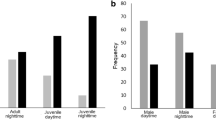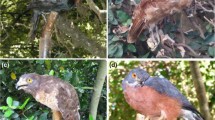Summary
Anti-predator behaviors of the bannertail kangaroo rat (Dipodomys spectabilis) toward snake predators were investigated. We induced responses by presenting a live (tethered) snake and an inflatable snake decoy to rats of known ages and sex in their territories. Comparisons of behaviors during spontaneous activity (baseline), naturally occurring snake-rat interactions, and experimental procedures further clarified anti-predator behaviors. The tethered snake immediately induced high rates of footdrumming (the repeated striking of the hind feet on the ground) in all rats (n=24) (Table 2), and individuals of both sexes and all ages footdrummed significantly more at the tethered snake than at the decoy. Other antipredator behaviors included alert postures, jumpback, kicking sand and avoidance. Juvenile rats exhibited more avoidance behavior and alert postures than adults and footdrummed at the decoy only if they experienced the snake first. We conclude that footdrumming functions as an individual alarm signal against predation by snakes in D. spectabilis. The drumming probably informs a snake that it has been detected and may cause it to leave. Because rats did not footdrum in response to aerial predators (owls), we suggest that kangaroo rats use different anti-predator strategies that depend on the kind of threat and the type of predator.
Similar content being viewed by others
References
Best TL (1972) Mound development by a pioneer population of the banner-tailed kangaroo rat, Dipodomys spectabilis bailey Goldman, in eastern New Mexico. Am Midl Nat 87:201–206
Box GE, Hunter WG, Hunter JS (1978) Statistics for experimenters. Wiley & Sons, New York, pp 232–235
Brown CH (1982) Ventriloquial and locatable vocalizations in birds. Z Tierpsychol 59:338–350
Burley RA (1980) Pre-copulatory and copulatory behavior in relation to stages of the oestrous cycle in the female Mongolian gerbil. Behaviour 72:211–241
Clark MM, Galef BG (1979) A sensitive period for the maintenance of emotionality in Mongolian gerbils. J Comp Physiol Psychol 93:200–210
Coss RG, Owings DH (1978) Snake-directed behavior by snake naive and experienced California ground squirrels in a simulated burrow. Z Tierpsychol 48:421–435
Dunford C (1977) Kin selection for ground squirrel alarm calls. Am Nat 111:782–785
Eisenberg JF (1963) The behavior of heteromyid rodents. Univ Calif Publ Zool 69:1–100
Eisenberg JF (1975) The behavior patterns of desert rodents. In: Prakash I, Ghosh PK (eds) Rodents in desert environments. W Junk, The Hague, pp 189–224
Fitch HS (1948) Ecology of the California ground squirrel on grazing lands. Am Midl Nat 39:513–596
Green PR (1982) Problems in animal perception and learning and their implications for models of imprinting. In: Bateson PG, Klopfer PH (eds) Perspectives in ethology, vol 5. Plenum Press, New York, pp 243–270
Hartline PH (1971) Physiological basis for detection of sound and vibrations in snakes. J Exp Biol 54:349–371
Harvey PH, Greenwood PJ (1978) Anti-predator defence strategies: some evolutionary problems. In: Krebs JR, Davies NB (eds) Behavioral ecology and sociobiology: an evolutionary approach. Blackwell Scientific Publications, London, pp 129–151
Hatt RT (1932) The vertebral columns of ricochetal rodents. Bull Am Mus Nat Hist 63:599–738
Hennessy DF, Owings DH (1978) Snake species discrimination and the role of olfactory cues in the snake-directed behavior of the California ground squirrel. Behaviour 65:115–124
Hennessy DF, Owings DH, Rowe MP, Coss RG, Leger DW (1981) The information afforded by a variable signal: constraints on snake-elicited tail flagging by California ground squirrels. Behaviour 78:189–226
Holdenried R (1957) Natural history of the bannertail kangaroo rat in New Mexico. J Mammal 38:330–350
Howell AE (1932) The saltatorial rodent Dipodomys: the functional and comparative anatomy of its muscular and osseous systems. Proc Am Acad Arts Sci 67:377–536
Jones WT (1984) Natal philopatry in bannertailed kangaroo rats. Behav Ecol Sociobiol 15:151–155
Kenagy GJ (1976) Field observation of male fighting, drumming and copulation in the Great Basin kangaroo rat, Dipodomys microps. J Mammal 57:781–785
Klump GM, Shalter MD (1984) Acoustic behaviour of birds and mammals in the predator context. Z Tierpsychol 66:189–226
Leger DW, Owings DH, Boal LM (1979) Contextual information and differential responses to alarm whistles in California ground squirrels. Z Tierpsychol 49:142–155
Mares MA (1980) Covergent evolution among desert rodents: a global perspective. Bull Carn Mus Nat Hist 16:1–51
Marler P (1955) Characteristics of some animal calls. Nature 176:61–68
Matocha KG (1977) The vocal repertoire of Spermophilus tridecemlineatus. Am Midl Nat 98:482–487
Maynard Smith J (1965) The evolution of alarm calls. Am Nat 99:59–63
Nikolai JC, Bramble DM (1983) Morphological structure and function in desert heteromyid rodents. Great Basin Nat 7:44–64
Owings DH, Hennessy DF (1984) The importance of variation in sciurid visual and vocal communication. In: Murie JO, Michener GR (eds) The biology of ground-dwelling squirrels. University of Nebraska, Lincoln, pp 169–200
Owings DH, Owings SC (1979) Snake-directed behavior by blacktailed prairie dogs (Cynomys ludovicianus). Z Tierpsychol 49:35–54
Randall JA (1984) Territorial defense and advertisement by footdrumming in bannertail kangaroo rats (Dipodomys spectabilis) at high and low population densities. Behav Ecol Sociobiol 16:11–20
Randall JA (1986) Lack of gonadal control of the dorsal gland and sandbathing in male and female bannertail kangaroo rats (Dipodomys spectabilis). Horm Behav 20:95–105
Randall JA (in press) Field observations of male competition and mating in Merriam's and bannertail kangaroo rats. Am Midl Nat
Richarson WB (1942) Reaction toward snakes as shown by the woodrat Neotoma albigula. J Comp Physiol 34:1–10
Schwagmeyer PL (1980) Alarm calling behavior of the thirteen-lined ground squirrel, Spermophilus tridecemlineatus. Behav Ecol Sociobiol 7:195–200
Sherman PW (1977) Nepotism and the evolution of alarm calls. Science 197:1246–1253
Sherman PW (1985) Alarm calls of Belding's ground squirrels to aerial predators: nepotism or self-preservation? Behav Ecol Sociobiol 17:313–323
Smythe N (1970) On the existence of “pursuit invitation” signals in mammals. Am Nat 104:491–494
Sokal RR, Rohlf FJ (1981) Biometry, 2nd ed. Freeman, San Francisco, p 368
Tennant A (1984) The snakes of Texas. Texas Monthly, Austin, p 561
Webster DB (1962) A function of the enlarged middle ear cavity of the kangaroo rat, Dipodomys. Physiol Zool 35:248–255
Webster DB, Webster M (1971) Adaptive value of hearing and vision in kangaroo rats predator avoidance. Brain Behav Evol 4:310–322
Woodland DJ, Jaafar Z, Knight M (1980) The “pursuit deterrent” function of alarm signals. Am Nat 115:748–753
Author information
Authors and Affiliations
Rights and permissions
About this article
Cite this article
Randall, J.A., Stevens, C.M. Footdrumming and other anti-predator responses in the bannertail kangaroo rat (Dipodomys spectabilis). Behav Ecol Sociobiol 20, 187–194 (1987). https://doi.org/10.1007/BF00299732
Received:
Accepted:
Issue Date:
DOI: https://doi.org/10.1007/BF00299732




